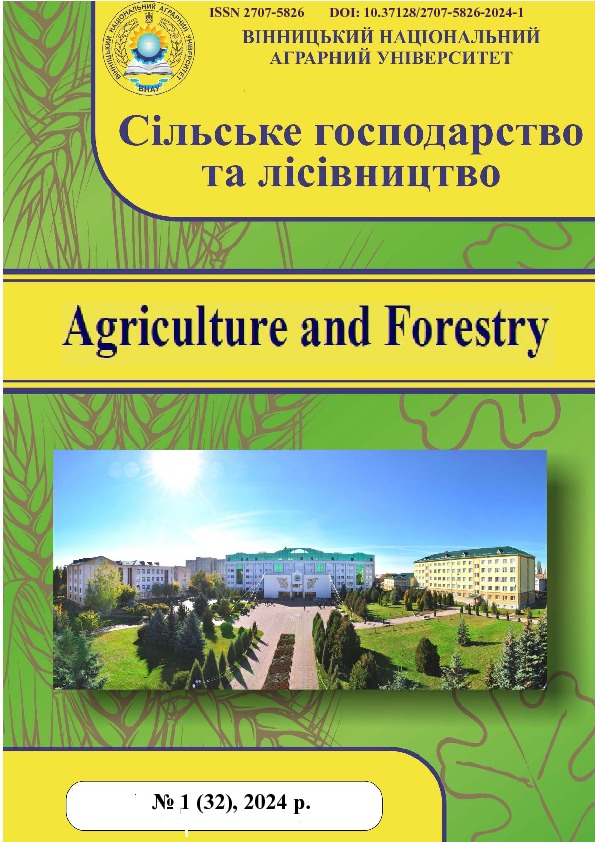id: 35709
Назва: Intensity of heavy metals accumulation by vegetable cultures for different duration of their vegetation
Автори: Alieksieiev O., Vradii O. Salyamon A.
Ключові слова: heavy metals, excess, intensity of accumulation, vegetables, maximum permissible concentration
Дата публікації: 2024-05-03 17:30:59
Останні зміни: 2024-05-03 17:30:59
Рік видання: 2024
Аннотація: It was analyzed that, in addition to pesticides and nitrates, heavy metals also belong to the substances that pollute soils, food and feed. Heavy metals such as Pb, Cd, Zn, Cu, Hg and others are recognized as the most dangerous pollutants. It was found that about 90% of heavy metals entering the environment are accumulated by soils, which then migrate into natural waters, are absorbed by plants and enter food chains. A certain amount of substances harmful to living organisms can be assimilated by cultivated plants and further along the food chain enter the human body. It was established that as a result of intensive farming, the amount of heavy metals in the soil is constantly increasing, which leads to a decrease in productivity and a deterioration in the quality of products, in particular, vegetable products. It is vegetable crops that provide the population with important food products, and industry with raw materials. Therefore, the study of the intensity of accumulation of heavy metals in vegetable products is relevant and necessary in modern conditions of production. The intensity of soil pollution was investigated and it was established that the maximum permissible concentrations were not exceeded. The highest content of heavy metals in the soil was observed for Zn – 21.4 mg/kg, and the lowest – for Cd – 0.31 mg/kg. The hazard ratio of heavy metals in the soil of the studied area was the highest for Zn. In medium-ripe vegetables, there is an excess of the maximum permissible concentrations for Pb in Cucurbita pepo var. Giromontina L. and Phaseolus L., for Cd – in Cucumis sativus L. and Lycopersicon L., Cucurbita pepo var. Giromontina L. and Phaseolus L., for Zn – in Phaseolus L., for Cu – there is no excess of maximum permissible concentrations. In late-ripening vegetables, there is an excess of the maximum allowable concentrations for Pb in all vegetables, for Cd – in Allium sativum L., Allium cepa L., Daucus carota subsp. sativus L. and Brassica oleracea L. var. capitata L. forma alba, for Zn – in Brassica oleracea L. var. capitata L. forma alba, for Cu – in all vegetables, except Brassica oleracea L. var. capitata L. forma alba. Cucurbita pepo var. Giromontina L. had the highest hazard ratio in medium-ripe vegetables for Cd, and the lowest hazard ratio for Phaseolus L. for Cu. Among late-ripening vegetables, the highest hazard ratio was for Allium sativum L. in terms of Pb, and the lowest in Brassica oleracea L. var. capitata L. forma alba for Cu. The highest coefficient of accumulation in mid-ripe vegetable samples was in Capsicum annuum L. for Cu, and the lowest for common Cucumis sativus L. for Pb. In late-ripening vegetable samples, the highest accumulation coefficient was in Allium sativum L. for Cu, and the lowest for Brassica oleracea L. var. capitata L. forma alba for Pb.
URI: http://socrates.vsau.org/repository/getfile.php/35709.pdf
Тип виданя: Статті у наукових фахових виданнях України (Copernicus та інші)
Видавництво: Сільське господарство та лісівництво. 2024. № 1 (32). С. 188-204. DOI:10.37128/2707-5826-2024-1-15
Розташовується в колекціях :
Ким внесений: Адміністратор
Файл : 35709.pdf Розмір : 928805 байт Формат : Adobe PDF Доступ : Загально доступний

| |
|
|